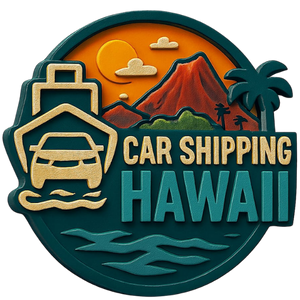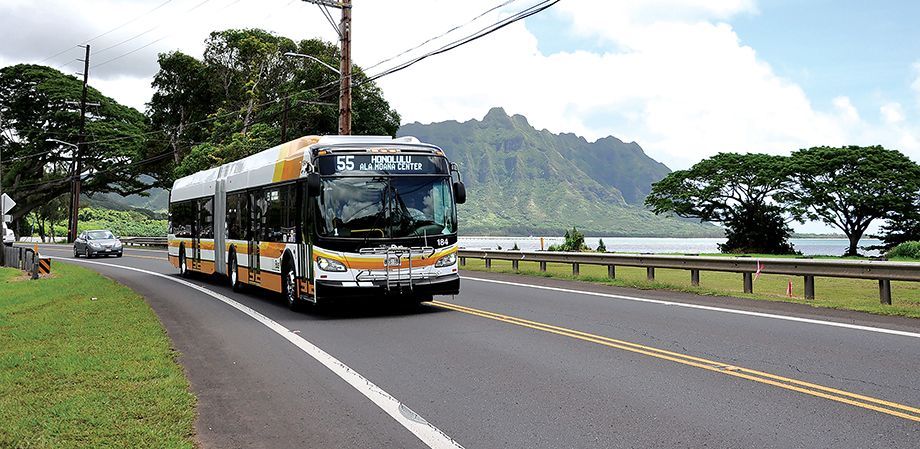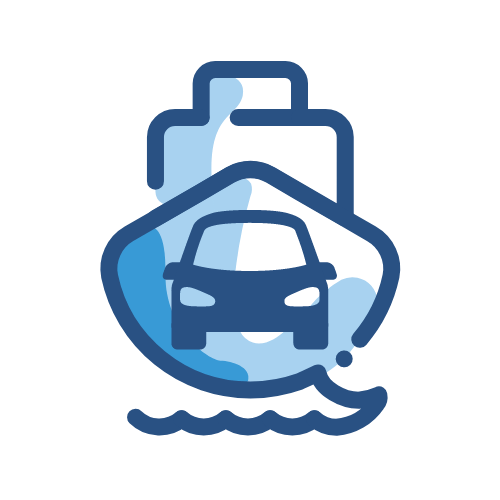These FMCSA Flatbed Load Securement Rules Can Keep You Safe on the Road
Load securement is nothing to play around with in the trucking industry. The average Flatbed trucker will spend most of their time transporting cargo from one place to the other. There’s always a risk with transporting freight, especially if it’s an extremely large load. In recent years, the FMCSA reported that thousands of crashes and casualties took place.
Truckers must be considerate of other drivers on the road as well. The only way they can truly deliver the goods in a safe and timely manner is by learning the rules of cargo securement set by the Federal Motor Carrier Safety Administration (FMCSA). Their guidelines have been around since the early 2000s. Flatbed truck drivers must abide by their rules at all times.
The FMCSA listed improper flatbed load securement as one of the biggest reasons why fatal accidents involving trucks and passenger vehicles take place. The rules aren’t perfect per say, but they’re a trucker's best bet for staying safe on the road. Using the recommended winch or the best tie-down method to secure a piece of cargo could prevent a trucker from being another statistic. The FMCSA’s main mission is to help ensure that a trucker keeps their cargo secured at all times.
Here are some flatbed load securement tips to keep in mind for your next job.
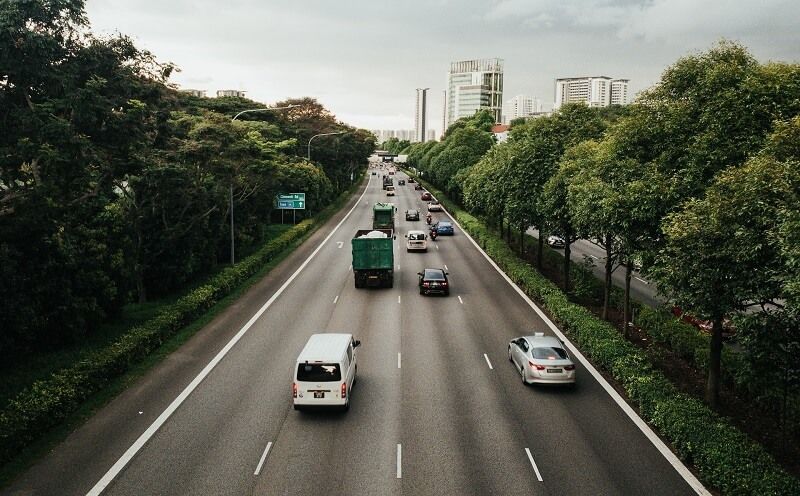
The Load Securement Checklist
Traveling on the road for long periods of time can make us forgetful at times. That’s why it helps to keep a load securement checklist handy:
1. Cross-Check Your Specs On Trailer:
There’s no harm in checking your load twice. After all, you want to make sure your load is properly loaded onto the back of your flatbed trailer. If you even have the slightest doubt, do a double-check. Check everything from your trailer’s load rating to verifying your truck’s towing capacity. You can find the weight ratings on the inside of the driver’s door and the trailer’s identification plate. The last thing you want to do is exceed any weight limitations. Truckers should know that the maximum weight for a typical flatbed trailer is 48,000 lbs. Anything over that will require extra securement and tie-down methods.
2. Evenly Distribute Cargo on Bed:
Additionally, if you’re hauling a large load, make sure its weight is evenly distributed along your flatbed. You should always know how the weight of your load and the dimensions of your truck’s trailer will affect one another. Depending on the placement of your materials, it will need to be balanced and secured using the right equipment. The FMCSA regulations can also help you determine which piece of equipment to use to secure your load. In general, though, place heavier materials on the lower deck and right above the truck’s axles. More than half of the load should be on the front of the trailer. This takes the pressure off the back end and prevents your cargo from shifting.
3. Tie-Down Cargo with Right Equipment:
After evenly distributing your cargo along your flatbed trailer, it’s time to tie down your materials. You’ll need to know how many tie-downs you’ll need and how to place them. FMCSA states that there should be at least 1 tie down for every 10 feet of cargo. Additionally, the WLL of all your tie-down devices should be half of the cargo’s weight.
Moreover, tie down straps, chains and chain binders keep your cargo in place during transport. For instance, cargo straps are better suited for materials like lumber. Unfortunately, they’re susceptible to damage and may need to be regularly repaired.
On the other hand, corner and edge protectors are both great at protecting your cargo and keeping straps looking brand new. Most importantly, check your cargo every couple of miles to make sure it hasn’t shifted and that your tie-downs are still intact.
Let’s check out some of the best tie-down methods used to secure your cargo:
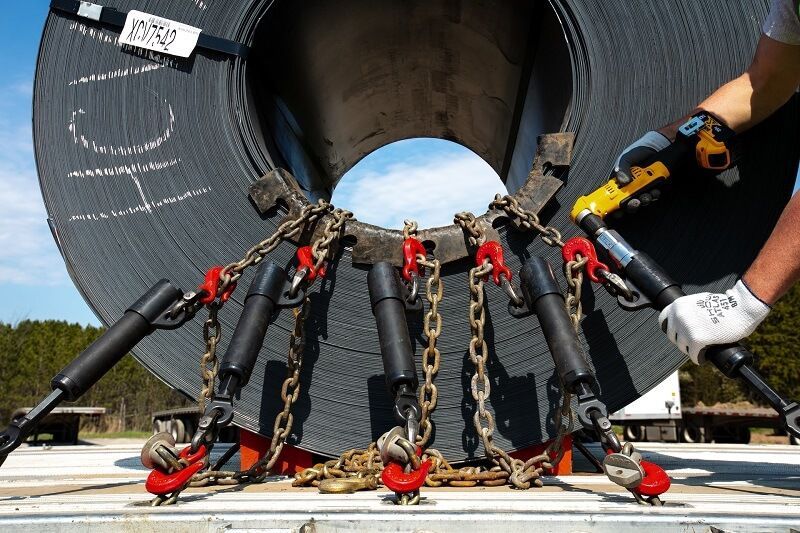
● Chain Binder: As previously mentioned, chain binders help secure your cargo on a flatbed truck. Furthermore, they apply tension to Transport Chains, helping to hold the cargo in place during transit. They even come in several different styles such as ratchet and lever binders. In particular, chain binders are best used for heavy loads such as aluminum, steel and farm equipment.
In greater detail, the binder can be connected to a load or an ICC Bar. Afterward, a chain is stretched out and the binder helps tighten it. Though, there are specific chains used to secure particular cargo. More importantly, chain binders can be used to prevent your cargo from shifting on the trailer.
● Transport Chains: These chains are a common tie-down method used to secure your cargo. The FMCSA states what the WLL of your chains should be for specific types of cargo. Moreover, these chains provide maximum strength and durability to keep your materials protected during transport. They can be positioned in several different ways to ensure the stability of your cargo. Additionally, Transport Chains can be used in conjunction with other tools to help increase tensioning over them and the cargo. This way, you won’t have to worry about your materials falling off. All in all, these heavy-duty chains make cargo securement all the easier.
● Cargo Straps: Moreover, the Cargo straps can add an extra layer of protection for your goods. In detail, they are connected to the ICC Bar. The Cargo Straps can be thrown over the cargo and tarp to secure everything with a winch bar. In particular, these straps come pretty strong too. For example, 4-inch straps can support up to 5,500 lbs of cargo.
Additionally, tarps are great for securing loads. They protect the cargo from outside forces and prevent it from blowing away. Furthermore, be sure to refer to the tarping requirements that are outlined in state and federal laws. Knowing the rules and regulations can go a long way in the end.
● Load Bars: Moreover, Load Bars can ensure your cargo remains secure. Equally important, the tie-down device will prevent it from falling off your trailer during transport. Not to mention, they are an affordable and efficient way to support your extremely heavy loads.
Specifically, they are placed between your cargo and the walls of your flatbed trailer to prevent them from shifting. Load Bars also help to evenly distribute the weight of your load within your trailer. This allows you to haul more without damaging your truck’s trailer. You can pair them with other tools like corner protectors and chains, to provide an optimal level of protection over your cargo. More importantly, Load Bars will help you stay compliant with the flatbed securement rules.
4. Choose Suitable Flatbed Tarps:
Tarping is another tie-down method every flatbed trucker should get familiar with. At the end of the day, they keep your cargo protected from bad weather and road conditions. There are a couple of aspects to keep in mind for properly tarping your cargo. Make sure to smooth out your tarp’s wrinkles, center the tarp, fold in any overlapping fabric to avoid wind issues and use ratchet straps to secure the tarp and cargo. Additionally, flatbed tarps come in all different kinds of configurations for certain types of cargo. For example, some tarps are made for Lumber, while others are made for Steel. Knowing what your job requires will help you choose the right type of Flatbed Tarp.
● Use Bungee and Corner Protector to Protect Tarps: As mentioned before, you can use Bungee Straps and Corner Protector to help secure your cargo. Additionally, they also prevent your flatbed tarps from getting damaged as well. Moreover, Bungee straps and Corner Protectors act as a protective barrier between your tarps and load. They not only add sufficient tensioning and securement of your load, but also they extend the life of your tarps. The two accessories keep your tarps from getting ripped apart or torn if your cargo has sharp edges. In the end, you won’t have to worry about tarps getting ruined. Not to mention, you can save on repair costs by making use of Bungee Straps and Corner Protectors.
5. Inspect Load Securement before Go:
You’ve learned all the regulations of the FMCSA and about common tie-down methods. You probably feel like you’re ready to start trucking, right? You’d be wrong. Before you hit the road, do a double check of everything. Check for any damages or defects to your hardware and cargo. Even address the smaller issues to avoid them turning into an even bigger problem. Not to mention, you’ll avoid having any accidents on the road, like losing your cargo. Even your Bungee Straps and chains can loosen along the way if not properly tensioned. Make a habit of inspecting your cargo and your equipment before taking off. You should check everything on breaks or whenever you stop for gas.
The Benefits Of Proper Load Securement

Speaking of double-checking your load, there are several perks to having your load properly secured. Making sure your load stays protected throughout the whole ride can be nerve-wrecking. Though, if you follow the flatbed load securement rules and use the right tools, you’ll be set. Let’s take a look at four benefits of proper load securement:
- Prevents Cargo Damage.
- You’ll arrive to your destination in a timely manner.
- It’ll save you tons of money on costly repairs.
- Most importantly, it’ll keep you and your cargo safe on the road.
In conclusion, securing your load should be your top priority on every job. Trucking is hard enough. Why not make it easier by learning how to properly secure your cargo? Even studying the FMCSA regulations can help make you a better trucker. At the end of the day, follow the rules, secure your load and keep yourself safe on the road.


